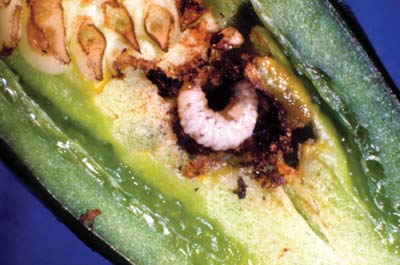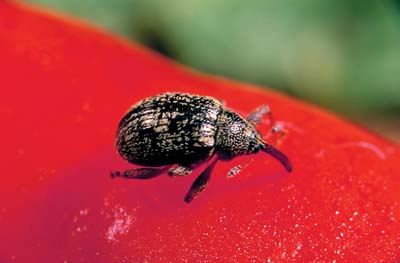Pepper Weevil, Anthonomus eugenii
(Coleoptera: Curculionidae)
The pepper weevil is found across the southernmost United States from California to Florida. Populations persist where food sources are available throughout the year. Pepper weevil may be a problem in northern states only if infested transplants are shipped north. The life cycle requires 20 to 30 days and is dependent upon the weather. Eight generations have been produced in a single year, but three to five generations per year is most common. Diapause does not occur in the pepper weevil and adults overwinter. Eggs are deposited in blossoms or fruit. They are white when first deposited but soon turn yellow. The larvae, which develop in the bud or fruit, are white to gray and have a yellowish-brown head. They lack legs and have a few large hairs or bristles. Pupation occurs in the blossom bud or fruit. The pupa is white when first formed but eventually becomes yellow with brown eyes. The adult is a small blackish beetle that is round in shape and has a large snout.
Host plants include pepper, tomato, and eggplant. Weed host plants include several species of nightshade. Both adults and larvae cause damage. Blossom buds and immature pods may be destroyed and bud drop may occur. Fruit deformation may also occur. Parasitoids of the pepper weevil are naturally occurring and help to maintain low populations. Management of pepper weevil is obtained by sampling using visual examination and yellow sticky traps. Action thresholds are set at one adult per 400 buds. Insecticides are commonly applied to the foliage once buds begin to form but may vary in effectiveness. Cultural control practices may include sanitation, crop rotation, destruction of alternate hosts, and planting resistant or tolerant varieties.
Images
To save the Web-optimized images shown below to your hard drive:
PC users: right click to "Save Picture (or Image) As..."
Mac users: click and drag to your desktop.
Copyright © 2005 University of Florida



